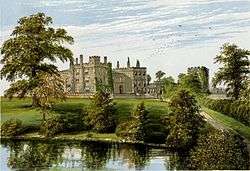Ripley Castle

Ripley Castle is a Grade I listed 14th-century country house in Ripley, North Yorkshire, England, some 5 km (3 miles) north of Harrogate.
The house is built of coursed squared gritstone and ashlar with grey slate and stone slate roofs. A central 2-storey block is flanked by a tower at one end and a 3-storey wing at the other.[1] A gatehouse which stands some 80 metres to the south of the main buildings is also Grade I listed. [2]
The castle has been the seat of the Ingleby baronets for centuries.
History
Sir Thomas Ingleby (c1290-1352) married the heiress Edeline Thwenge in 1308/9 and acquired the Ripley Castle estate with its mediaeval manor house as her dowry. His oldest son, also called Thomas (1310-1369), saved the king from being gored by a wild boar whilst on a hunting expedition and was knighted in return with the boar's head symbol as his crest. Sir John Ingleby (1434-1499) inherited the estate from his father at the age of five and built the castle gatehouse, before becoming a monk at Mount Grace Priory, near Northallerton and later the Bishop of Llandaff. His son, brought up by his deserted mother, was Sir William Ingleby (1518-1578), who was High Sheriff of Yorkshire in 1564-65. Sir William added the tower to the building in 1548. Two of his sons were fervent Catholics on the run from the authorities. Francis, a priest, was caught, sentenced and hanged, drawn and quartered in York; David escaped to die on the Continent.[3]
Sir William Ingleby (1546-1618) hosted James VI of Scotland when the king was en route to his coronation as James I of England in 1603. In 1605 he was involved in the Gunpowder Plot, allowing the plotters to stay at Ripley whilst they procured horses. He was arrested and charged with treason, but acquitted. Sir William Ingleby (1594-1652) supported Charles I during the Civil War, and was made Baronet Ingleby in 1642. He fought at Marston Moor in 1644, when the King's forces were totally routed, making his escape to Ripley and hiding in a priest hole while Oliver Cromwell billeted himself there for the night. His son, yet another William, 2nd Baronet (1620-1682) was very religious and managed to get the family’s entire fortune captured by rebels. On the death of the 4th Baronet in 1772 the baronetcy became extinct but was revived in 1781 for his illegitimate son John (1758-1815).[3]
Sir John undertook a major rebuild of the castle in 1783-86 by William Belwood but got into debt and had to flee overseas in 1794 for several years whilst timber from the estate was sold to raise money. He was High Sheriff for 1782–83 and MP for East Retford from 1790 to 1796. His son William (1783-1854) was a great eccentric, drinker and gambler and Member of Parliament (MP) for East Retford from 1807 to 1812 and High Sheriff in 1821. He adopted the surname of Amcotts-Ingilby (his mother was Elizabeth Amcotts) and demolished and rebuilt the village of Ripley, complete with a Continental style hotel-de-ville. Having no heir he left the Ripley estate to his first cousin, Henry John Ingilby.[3] The baronetcy was extinguished a second time.
Henry was created 1st Baronet Ingilby of the third creation in 1866. Ripley then descended to the present 6th Baronet.
The castle is still privately owned but open to the public for guided tours.
References
- ↑ "Ripley Castle, Ripley". British Listed Buildings. Retrieved 2013-02-20.
- ↑ "Name: GATEHOUSE APPROXIMATELY 80 METRES SOUTH OF RIPLEY CASTLE List entry Number: 1174136". English Heritage. Retrieved 26 August 2014.
- 1 2 3 "Ingilby History". Retrieved 2013-02-20.
External links
Coordinates: 54°02′28″N 1°34′05″W / 54.0410°N 1.5680°W